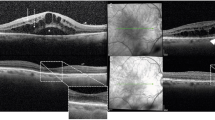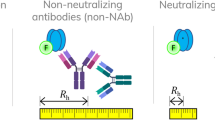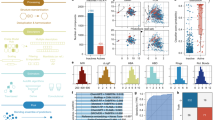Abstract
Purpose
A growing body of evidence points to a role for inflammation mediated by lymphocyte function-associated antigen-1 (LFA-1) and its ligand intercellular adhesion molecule-1 in the pathogenesis of diabetic macular oedema. This phase 1b clinical trial assessed the safety, tolerability, and pharmacokinetics of topically administered SAR 1118, a novel LFA-1 antagonist, in human subjects.
Methods
In this prospective, randomized, double-masked trial, 13 subjects scheduled for vitrectomy received one of three concentrations of topical SAR 1118 (0.1, 1.0, or 5.0%) twice daily for 1 week before surgery. Undiluted aqueous and vitreous samples were collected at surgery and analysed for the concentration of the medication.
Results
All subjects completed the entire course of medication. The only adverse events reported were instillation site irritation (4/13, 31%) and dysgeusia (3/13, 23%). These were mild and transient, occurring at the highest dose. Mean concentrations (ng/ml) of SAR 1118 in the aqueous humour were 0.25, 37.2, and 101.1 for the 0.1%, 1.0%, and 5.0% dose groups, respectively. SAR 1118 was below the level of detection (0.5 ng/ml) for all vitreous samples except in a single subject who had a history of prior vitrectomy and a dislocated intraocular lens.
Conclusions
Topical SAR 1118 was safe and well tolerated, and dose-dependent levels of drug were detected in aqueous. However, vitreous levels were below the threshold of detection with the concentrations tested. Further investigation of this medication for posterior segment applications would require intravitreal delivery or chemical modification of the drug.
Similar content being viewed by others
Log in or create a free account to read this content
Gain free access to this article, as well as selected content from this journal and more on nature.com
or
References
King H, Aubert RE, Herman WH . Global burden of diabetes, 1995–2025: prevalence, numerical estimates, and projections. Diabetes Care 1998; 21: 1414–1431.
Klein R, Klein BE, Moss SE, Davis MD, DeMets DL . The Wisconsin epidemiologic study of diabetic retinopathy. IV. Diabetic macular edema. Ophthalmology 1984; 91: 1464–1474.
Photocoagulation for diabetic macular edema. Early Treatment Diabetic Retinopathy Study report number 1. Early Treatment Diabetic Retinopathy Study research group. Arch Ophthalmol 1985; 103: 1796–1806.
Diabetic Retinopathy Clinical Research Network. Randomized trial evaluating ranibizumab plus prompt or deferred laser or triamcinolone plus prompt laser for diabetic macular edema. Ophthalmology 2010; 117: 1064–1077.
Scott IU, Edwards AR, Beck RW, Bressler NM, Chan CK, Elman MJ et al. A phase II randomized clinical trial of intravitreal bevacizumab for diabetic macular edema. Ophthalmology 2007; 114: 1860–1867.
Cunningham ET, Adamis AP, Altaweel M, Aiello LP, Bressler NM, D’Amico DJ et al. A phase II randomized double-masked trial of pegaptanib, an anti-vascular endothelial growth factor aptamer, for diabetic macular edema. Ophthalmology 2005; 112: 1747–1757.
Adamis AP, Berman AJ . Immunological mechanisms in the pathogenesis of diabetic retinopathy. Semin Immunopathol 2008; 30: 65–84.
Adamis AP . Is diabetic retinopathy an inflammatory disease? Br J Ophthalmol 2002; 86: 363–365.
Martidis A, Duker JS, Greenberg PB, Rogers AH, Puliafito CA, Reichel E et al. Intravitreal triamcinolone for refractory diabetic macular edema. Ophthalmology 2002; 109: 920–927.
Kern TS . Contributions of inflammatory processes to the development of the early stages of diabetic retinopathy. Exp Diabetes Res 2007; 2007: 95103.
McLeod DS, Lefer DJ, Merges C, Lutty GA . Enhanced expression of intracellular adhesion molecule-1 and P-selectin in the diabetic human retina and choroid. Am J Pathol 1995; 147: 642–653.
Miyamoto K, Khosrof S, Bursell SE, Rohan R, Murata T, Clermont AC et al. Prevention of leukostasis and vascular leakage in streptozotocin-induced diabetic retinopathy via intercellular adhesion molecule-1 inhibition. Proc Natl Acad Sci USA 1999; 96: 10836–10841.
Schroder S, Palinski W, Schmid-Schonbein GW . Activated monocytes and granulocytes, capillary nonperfusion, and neovascularization in diabetic retinopathy. Am J Pathol 1991; 139: 81–100.
Joussen AM, Murata T, Tsujikawa A, Kirchhof B, Bursell SE, Adamis AP . Leukocyte-mediated endothelial cell injury and death in the diabetic retina. Am J Pathol 2001; 158: 147–152.
Joussen AM, Poulaki V, Le ML, Koizumi K, Esser C, Janicki H et al. A central role for inflammation in the pathogenesis of diabetic retinopathy. Faseb J 2004; 18: 1450–1452.
Rao VR, Prescott E, Shelke NB, Trivedi R, Thomas P, Struble C et al. Delivery of SAR 1118 to the retina via ophthalmic drops and its effectiveness in a rat streptozotocin (STZ) model of diabetic retinopathy (DR). Invest Ophthalmol Vis Sci 2010; 51: 5198–5204.
Murphy CJ, Bentley E, Miller PE, McIntyre K, Leatherberry G, Dubielzig R et al. The pharmacological assessment of a novel lymphocyte function-associated antigen-1 antagonist (SAR 1118) for the treatment of keratoconjunctivitis sicca in dogs. Invest Ophthalmol Vis Sci 2011; 52: 3174–3180.
Flach AJ, Jampol LM, Weinberg D, Kraff MC, Yannuzzi LA, Campo RV et al. Improvement in visual acuity in chronic aphakic and pseudophakic cystoid macular edema after treatment with topical 0.5% ketorolac tromethamine. Am J Ophthalmol 1991; 112: 514–519.
Flach AJ, Dolan BJ, Irvine AR . Effectiveness of ketorolac tromethamine 0.5% ophthalmic solution for chronic aphakic and pseudophakic cystoid macular edema. Am J Ophthalmol 1987; 103: 479–486.
Faia LJ, Sen HN, Li Z, Yeh S, Wroblewski KJ, Nussenblatt RB . Treatment of inflammatory macular oedema with humanized anti-CD11a antibody therapy. Invest Ophthalmol Vis Sci 2011; 52(9): 6919–6924.
Author information
Authors and Affiliations
Corresponding author
Ethics declarations
Competing interests
Charles Semba and Thomas R Gadek are employees of SARcode Corporation. The remaining authors declare no conflict of interest.
Additional information
This work was presented at the ARVO Annual Meeting in May 2011. Daniel Paskowitz is a Fellow of the Heed Ophthalmic Foundation.
Rights and permissions
About this article
Cite this article
Paskowitz, D., Nguyen, Q., Gehlbach, P. et al. Safety, tolerability, and bioavailability of topical SAR 1118, a novel antagonist of lymphocyte function-associated antigen-1: a phase 1b study. Eye 26, 944–949 (2012). https://doi.org/10.1038/eye.2012.68
Received:
Accepted:
Published:
Issue date:
DOI: https://doi.org/10.1038/eye.2012.68
Keywords
This article is cited by
-
Selective Pharmacologic Therapies for Dry Eye Disease Treatment: Efficacy, Tolerability, and Safety Data Review from Preclinical Studies and Pivotal Trials
Ophthalmology and Therapy (2022)
-
Dry Eye and Refractive Surgery Outcomes
Current Ophthalmology Reports (2016)
-
The Future of Dry Eye Treatment: A Glance into the Therapeutic Pipeline
Ophthalmology and Therapy (2015)
-
Inhibition of LFA-1/ICAM-1-mediated cell adhesion by stilbene derivatives from Rheum undulatum
Archives of Pharmacal Research (2012)



